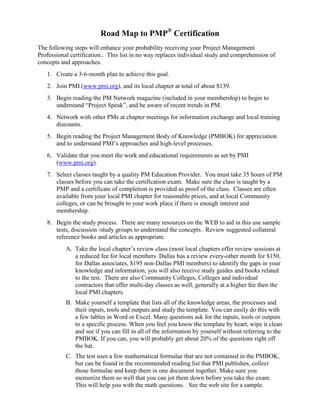Road Map To PMP Certification
- 1. Road Map to PMP® Certification The following steps will enhance your probability receiving your Project Management Professional certification.. This list in no way replaces individual study and comprehension of concepts and approaches. 1. Create a 3-6-month plan to achieve this goal. 2. Join PMI (www.pmi.org), and its local chapter at total of about $139. 3. Begin reading the PM Network magazine (included in your membership) to begin to understand “Project Speak”, and be aware of recent trends in PM. 4. Network with other PMs at chapter meetings for information exchange and local training discounts. 5. Begin reading the Project Management Body of Knowledge (PMBOK) for appreciation and to understand PMI’s approaches and high-level processes. 6. Validate that you meet the work and educational requirements as set by PMI (www.pmi.org). 7. Select classes taught by a quality PM Education Provider. You must take 35 hours of PM classes before you can take the certification exam. Make sure the class is taught by a PMP and a certificate of completion is provided as proof of the class. Classes are often available from your local PMI chapter for reasonable prices, and at local Community colleges, or can be brought to your work place if there is enough interest and membership. 8. Begin the study process. There are many resources on the WEB to aid in this use sample tests, discussion /study groups to understand the concepts. Review suggested collateral reference books and articles as appropriate. A. Take the local chapter’s review class (most local chapters offer review sessions at a reduced fee for local members Dallas has a review every-other month for $150, for Dallas associates, $195 non-Dallas PMI members) to identify the gaps in your knowledge and information, you will also receive study guides and books related to the test. There are also Community Colleges, Colleges and individual contractors that offer multi-day classes as well, generally at a higher fee then the local PMI chapters. B. Make yourself a template that lists all of the knowledge areas, the processes and their inputs, tools and outputs and study the template. You can easily do this with a few tables in Word or Excel. Many questions ask for the inputs, tools or outputs to a specific process. When you feel you know the template by heart, wipe it clean and see if you can fill in all of the information by yourself without referring to the PMBOK. If you can, you will probably get about 20% of the questions right off the bat. C. The test uses a few mathematical formulae that are not contained in the PMBOK, but can be found in the recommended reading list that PMI publishes, collect those formulae and keep them in one document together. Make sure you memorize them so well that you can jot them down before you take the exam. This will help you with the math questions. See the web site for a sample.
- 2. 9. Start memorizing the PMI terms in the PMBOK glossary. This is also reproduced in the back of Perot Systems Project Management student workbooks. 10. Study the PMBOK in detail (taking notes), especially the details within the process groups. 11. At the three-months prior to the time you want to take the test, apply to PMI to obtain an exact test date apx. $405. 12. At one month out take the PM prep class again to solidify your understanding and identify any continuing learning gaps ($150). Continue your study efforts as appropriate. 13. One week out begin retaking the sample tests provided from a variety of sources (WEB other study guides. Research your missed answers to identify learning gaps. This will familiarize you to the test environment and review your PMI attitudes and approaches. You must answer the PMI way, not necessarily what your experience may dedicate. 14. On the day before the test drive to the location to eliminate any stress in finding the site. 15. Do not study anymore and get a good night’s sleep to be fresh for the test the next day. Eat a good breakfast and challenge the day! Congratulate yourself for PASSING and taking a major step in your professionalism.


